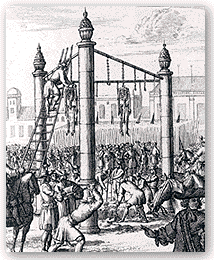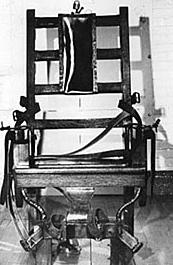
Early Death Penalty Laws
The earliest death penalty laws date back to the Eighteenth Century B.C. in the Code of King Hammaurabi of Babylon. The death penalty was also a part of the Hittite Code, the Draconian Code of Athens (which made death the only punishment for all crimes), and the Roman Law of the Twelve Tablets. Death sentences were carried out by crucifixion, drowning, beating to death, burning alive, and impalement.
However, until the eighteenth century,
a simple sentence of death was not the harshest punishment for criminal
behavior. Torture was. People found guilty of major crimes
(often minor crimes by our standards) would be tortured to death, and the
torture was so cruel that death came as a relief. Condemned persons
were commonly boiled, burned, roasted on spits, drawn and quartered, broken
on wheels, disemboweled, slowly dismembered, or torn apart by horses.
These tortures often lasted for days, and were considered entertainment
by the townspeople who would attend these punishments. 
In the Tenth Century A.D., Britain's
typical method of execution was hanging. After a brief hiatus from
the death penalty by William the Conqueror (who restricted execution to
times of war), Henry VIII executed nearly 72.000 people. (We must
assume the ban on execution was lifted.) The death penalty of this
time consisted of many forms of torture (drawing and quartering, boiling,
burning at the stake) in addition to beheading and hanging. Executions
were carried out for such capital offenses as marrying a Jew, not confessing
to a crime, and treason.
Courtesy of Museum
of London
During the next few centuries in Britain, the number of capital crimes continued to rise. By the 1700's, 222 crimes were punishable by death, including stealing, cutting down a tree, and robbing a rabbit warren. Due to the severity of the penalty of death, many juries would not convict defendants if the offense was not serious. This led to reforms in Britain's death penalty. From 1823 ot 1837, the death penalty was eliminated for over 100 of the 222 crimes punishable by death.
You may ask, "Why is all this British history important?" The answer is: Britain influenced America's use of the death penalty more than any other country did. Therefore, it leads us up to...
The Death Penalty in America
Colonial Times
When European settlers came to the new
world, they brought the practice of capital punishment. The first
recorded execution in the new colonies was that of Captain George Kendall
in the Jamestown colony of Virginia in 1608, who was accused of being a
spy for Spain. Laws regarding the punishment of death varied from
colony to colony. Virginia governor Sir Thomas Dale enacted the Divine,
Moral and Marital Laws, which provided the death penalty for even minor
offenses (such as killing chickens, stealing grapes, and trading with Indians).
The Massachusetts Bay Colony held its first execution in 1630, even though
the Capital Laws of New England did not go into effect until years later.
The New York Colony instituted the Duke's Laws of 1665 (which provided
for the punishment of death for striking one's mother or father, or denying
the "true God.")
 American
intellectuals who opposed the death penalty found comfort in Cesare Beccaria's
1769 essay, On Crimes and Punishment, in which he theorized that there
was no justification for the state taking a life. Thomas Jefferson,
in an attempt to reform Virginia's harsh death penalty laws, proposed a
bill that suggested that capital punishment be used only for the crimes
of murder and treason. It was defeated by only one vote.
American
intellectuals who opposed the death penalty found comfort in Cesare Beccaria's
1769 essay, On Crimes and Punishment, in which he theorized that there
was no justification for the state taking a life. Thomas Jefferson,
in an attempt to reform Virginia's harsh death penalty laws, proposed a
bill that suggested that capital punishment be used only for the crimes
of murder and treason. It was defeated by only one vote.
Courtesy of Constitution.org
Dr. Benjamin Rush, a signer of the Declaration of Independence and founder of the Pennsylvania Prison Society, challenged the idea that the death penalty served as a deterrent. He gained support in people of high respect, such as Benjamin Franklin and Philadelphia Attorney General William Bradford. Bradford believed the death penalty should be retained, but should be limited to only some crimes. He later led Pennsylvania to become the first state to consider degrees of murder based on liability. Later, Pennsylvania became the repealed the death penalty for all offenses except first degree murder.
Changes in Death Penalty Laws
Serious movement towards reform of the
death penalty began to show beginning in the early nineteenth century.
Many states reduced the number of their capital crimes and built state
penitentiaries. Pennsylvania became the first state to move executions
away from the public eye and carry them out in correctional facilities.
Michigan became the first state to abolish the death penalty for all crimes
except treason (1846). Later, Wisconsin and Rhode Island abolished
the death penalties for all crimes.
 Although
some U.S. states began abolishing the death penalty, most states held onto
capital punishment. Some states made more capital offenses, especially
for offenses committed by slaves. In 1838, in an effort to make the
death penalty more palatable to the public, some states passed laws against
mandatory death sentencing, instead enacting discretionary death penalty
statues. With the exception of a small number of rarely committed
crimes in a few jurisdictions, all mandatory capital punishment laws had
been abolished by 1963. image courtesy
of avstop.com
Although
some U.S. states began abolishing the death penalty, most states held onto
capital punishment. Some states made more capital offenses, especially
for offenses committed by slaves. In 1838, in an effort to make the
death penalty more palatable to the public, some states passed laws against
mandatory death sentencing, instead enacting discretionary death penalty
statues. With the exception of a small number of rarely committed
crimes in a few jurisdictions, all mandatory capital punishment laws had
been abolished by 1963. image courtesy
of avstop.com
During the Civil War, the death penalty waned, as more attention was given to the anti-slavery movement. After the war, new means of executions emerged. The electric chair was introduced at the end of the century.
Early and Mid Twentieth Century
From 1907 to 1917, six states completely
outlawed the death penalty and three limited it to rarely committed crimes,
such as treason and first degree murder of a law enforcement official.
However, this reform was short lived. The panic caused by the Russian
Revolution and the United States' entrance into World War I allowed for
five of the six abolitionist states to reinstate the death penalty.
Nevada, searching for a more humane way to execute its prisoners, developed cyanide gas in 1924. The gas chamber was invented soon after it was discovered that the gas could not just be pumped into the inmate's cell while he slept.
From the 1920's to the 1940's, there was a resurgence in the use of the death penalty. During the Great Depression and Prohibition, the 30's, there were more executions per year than at any other time in American history: an average of 167.
In the 1950's, public sentiment began
to turn away from capital punishment. Many allied nations either
abolished or severely limited the death penalty, and in the U.S., the number
of executions dropped dramatically. In 1966, support reached an all
time low, hovering at just 42%.
All information from MSU's Death Penalty
info site. For more complete history, go to www.deathpenaltyinfo.msu.edu
BACK TO MCM'S
pRO dEATH pENALTY sITE